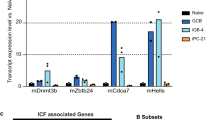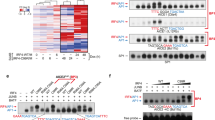Abstract
During B lymphopoiesis, recombination of the locus encoding the immunoglobulin κ-chain complex (Igk) requires expression of the precursor to the B cell antigen receptor (pre-BCR) and escape from signaling via the interleukin 7 receptor (IL-7R). By activating the transcription factor STAT5, IL-7R signaling maintains proliferation and represses Igk germline transcription by unknown mechanisms. We demonstrate that a STAT5 tetramer bound the Igk intronic enhancer (Eκi), which led to recruitment of the histone methyltransferase Ezh2. Ezh2 marked trimethylation of histone H3 at Lys27 (H3K27me3) throughout the κ-chain joining region (Jκ) to the κ-chain constant region (Cκ). In the absence of Ezh2, IL-7 failed to repress Igk germline transcription. H3K27me3 modifications were lost after termination of IL-7R–STAT5 signaling, and the transcription factor E2A bound Eκi, which resulted in acquisition of H3K4me1 and acetylated histone H4 (H4Ac). Genome-wide analyses showed a STAT5 tetrameric binding motif associated with transcriptional repression. Our data demonstrate how IL-7R signaling represses Igk germline transcription and provide a general model for STAT5-mediated epigenetic transcriptional repression.
This is a preview of subscription content, access via your institution
Access options
Subscribe to this journal
Receive 12 print issues and online access
$209.00 per year
only $17.42 per issue
Buy this article
- Purchase on Springer Link
- Instant access to full article PDF
Prices may be subject to local taxes which are calculated during checkout







Similar content being viewed by others
Accession codes
References
Clark, M.R., Cooper, A.B., Wang, L. & Aifantis, I. The pre-B cell receptor in B cell development: recent advances, persistent questions and conserved mechanisms. Curr. Top. Microbiol. Immunol. 290, 87–103 (2005).
Pelanda, R., Braun, U., Hobeika, E., Nussenzweig, M.C. & Reth, M.B cell progenitors are arrested in maturation but have intact VDJ recombination in the absence of Ig-α and Ig-β. J. Immunol. 169, 865–872 (2002).
Shimizu, T., Mundt, C., Licence, S., Melchers, F. & Martensson, I. VpreB1/VpreB2/lambda 5 triple-deficient mice show impaired B cell development but functional allelic exclusion of the IgH locus. J. Immunol. 168, 6286–6293 (2002).
Herzog, S., Reth, M. & Jumaa, H. Regulation of B-cell proliferation and differentiation by pre-B-cell receptor signalling. Nat. Rev. Immunol. 9, 195–205 (2009).
Erlandsson, L. et al. Both the pre-BCR and the IL-7Rα are essential for expansion at the pre-BII cell stage in vivo. Eur. J. Immunol. 35, 1969–1976 (2005).
Fleming, H.E. & Paige, C.J. Pre-B cell receptor signaling mediates selective response to IL-7 at the pro-B to pre-B cell transition via an ERK/MAP kinase-dependent pathway. Immunity 15, 521–531 (2001).
Zhang, L., Reynolds, T.L., Shan, S. & Desiderio, S. Coupling of V(D)J recombination to cell cycle suppresses genomic instability and lymphoid tumorigenesis. Immunity 34, 163–174 (2011).
Alt, F.W., Blackwell, T.K. & Yancopoulos, G.D. Development of the primary antibody repertoire. Science 238, 1079–1087 (1987).
Schlissel, M.S. & Stanhope-Baker, P. Accessibility and the developmental regulation of V(D)J recombination. Semin. Immunol. 9, 161–170 (1997).
Amin, R.H. et al. Biallelic, ubiquitous transcription from the distal germline Ig-κ locus promoter during B cell development. Proc. Natl. Acad. Sci. USA 106, 522–527 (2009).
Schlissel, M.S. Regulation of activation and recombination of the murine Ig-κ locus. Immunol. Rev. 200, 215–223 (2004).
Gorman, J.R. et al. The Igκ 3′ enhancer influences the ratio of Igκ versus Igλ B lymphocytes. Immunity 5, 241–252 (1996).
Inlay, M., Alt, F.W., Baltimore, D. & Xu, Y. Essential roles of the κ-light chain intronic enhancer and 3′ enhancer in κ rearrangement and demethylation. Nat. Immunol. 3, 463–468 (2002).
Xu, Y., Davidson, L., Alt, F.W. & Baltimore, D. Deletion of the Ig-κ light chain intronic enhancer/matrix attachment region impairs but does not abolish VκJκ rearrangement. Immunity 4, 377–385 (1996).
Lazorchak, A.S., Schlissel, M.S. & Zhuang, Y. E2A and IRF-4/Pip promote chromatin modification and transcription of the immunoglobulin κ locus in pre-B cells. Mol. Cell Biol. 26, 810–821 (2006).
Mandal, M. et al. Ras orchestrates cell cycle exit and light chain recombination during early B cell development. Nat. Immunol. 10, 1110–1117 (2009).
Inlay, M.A., Tian, H., Lin, T. & Xu, Y. Important roles for E protein binding sites within the immunoglobulin κ chain intronic enhance in activating V-κ J-κ rearrangement. J. Exp. Med. 200, 1205–1211 (2004).
Bain, G. et al. E2A proteins are required for proper B cell development and initiation of immunoglobulin gene rearrangements. Cell 79, 885–892 (1994).
Johnson, K. et al. Regulation of immunoglobulin light-chain recombination by the transcription factor IRF-4 and the attenuation of interleukin-7 signaling. Immunity 28, 335–345 (2008).
Lu, R., Kay, L., Lancki, D.W. & Singh, H. IRF-4,8 orchestrate the pre-B to B transition in lymphocyte development. Genes Dev. 17, 1703–1708 (2003).
Ma, S., Turetsky, A., Trinh, L. & Lu, R. IFN regulatory factor 4 and 8 promote Ig light chain κ locus activation in pre-B cell development. J. Immunol. 177, 7898–7904 (2006).
Cedar, H. & Bergman, Y. Epigenetics of haematopoietic cell development. Nat. Rev. Immunol. 11, 478–488 (2011).
Xu, C.-R. & Feeney, A.J. The epigenetic profile of Ig genes is dynamically regulated during B cell differentiation and is modulated by pre-B cell receptor signaling. J. Immunol. 182, 1362–1369 (2009).
Beck, K., Peak, M.M., Ota, T., Nemazee, D. & Murre, C. Distinct roles for E12 and E47 in B cell specification and the sequential rearrangement of immunoglobulin light chain loci. J. Exp. Med. 206, 2271–2284 (2009).
Lin, Y.C. et al. A global network of transcription factors, involving E2A, EBF1 and Foxo1, that orchestrates B cell fate. Nat. Immunol. 11, 635–643 (2010).
Liu, Y., Subrahmanyam, R., Chakroborty, T., Sen, R. & Desiderio, S. A plant homeodomain in RAG-2 that binds hypermethylated lysine 4 of histone H3 is necessary for efficient antigen-receptor-gene rearrangement. Immunity 27, 561–571 (2007).
Ji, Y. et al. The in vivo pattern of binding of RAG1 and RAG2 to antigen receptor loci. Cell 141, 419–431 (2010).
Flemming, A., Brummer, T., Reth, M. & Jumaa, H. The adaptor protein SLP-65 acts as a tumor suppressor that limits pre-B cell expansion. Nat. Immunol. 4, 38–43 (2003).
Xu, S., Lee, K.G., Huo, J., Kurosaki, T. & Lam, K.P. Combined deficiencies in Bruton tyrosine kinase and phospholipase Cγ2 arrest B-cell development at a pre-BCR+ stage. Blood 109, 3377–3384 (2007).
van Loo, P.F., Dingjan, G.M., Maas, A. & Hendriks, R.W. Surrogate-light-chain silencing is not critical for the limitation of pre-B cell expansion but is for the termination of constitutive signaling. Immunity 27, 1–13 (2007).
Malin, S. et al. Role of STAT5 in controlling cell survival and immunoglobulin gene recombination during pro-B cell development. Nat. Immunol. 11, 171–179 (2010).
Herzog, S. et al. SLP-65 regulates immunoglobulin light chain gene recombination through the PI(3)K-PKB-Foxo pathway. Nat. Immunol. 9, 623–631 (2008).
Tokoyoda, K., Egawa, T., Sugiyama, T., Choi, B.I. & Nagasawa, T. Cellular niches controlling B lymphocyte behavior within bone marrow during development. Immunity 20, 335–344 (2004).
Sen, R. & Baltimore, D. Multiple nuclear factors interact with the immunoglobulin enhancer sequences. Cell 46, 705–716 (1986).
Heintzman, N.D. et al. Histone modifications at human enhancers reflect global cell-type-specific gene expression. Nature 459, 108–112 (2009).
Vettermann, C. & Schlissel, M.S. Allelic exclusion of immunoglobulin genes: models and mechanisms. Immunol. Rev. 237, 22–42 (2010).
Quong, M.W. et al. Receptor editing and marginal zone B cell development are regulated by the helix-loop-helix protein, E2A. J. Exp. Med. 199, 1101–1112 (2004).
Romanow, W.J. et al. E2A and EBF act in synergy with the V(D)J recombinase to generate a diverse immunoglobulin repertoire in nonlymphoid cells. Mol. Cell 5, 343–353 (2000).
Margueron, R. & Reinberg, D. The polycomb complex PRC2 and its mark in life. Nature 469, 343–349 (2011).
Su, I.H. et al. Ezh2 controls B cell development through histone H3 methylation and Igh rearrangement. Nat. Immunol. 4, 124–131 (2003).
Stocklin, E., Wissler, M., Gouilleux, F. & Groner, B. Functional interactions between Stat5 and the glucocorticoid receptor. Nature 383, 726–728 (1996).
Kornfeld, J.-W. et al. The different functions of Stat5 and chromatin alteration through Stat5 proteins. Front. Biosci. 13, 6237–6254 (2008).
Moriggl, R. et al. Stat5 tetramer formation is associated with leukemogenesis. Cancer Cell 7, 87–99 (2005).
Soldaini, E. et al. DNA binding site selection of dimeric and tetrameric Stat5 proteins reveals a large repertoire of divergent tetrameric Stat5a binding sites. Mol. Cell Biol. 20, 389–401 (2000).
Bertolino, E. et al. Regulation of interleukin 7-dependent immunoglobulin heavy-chain variable gene rearrangements by transcription factor STAT5. Nat. Immunol. 6, 836–843 (2005).
Northrup, D.L. & Zhao, K. Application of ChIP-seq and related techniques to the study of immune function. Immunity 34, 830–842 (2011).
Zee, B.M. et al. In vivo residue-specific histone mehtylation dynamics. J. Biol. Chem. 285, 3341–3350 (2010).
Spicuglia, S. et al. TCRα enhancer activation occurs via a conformational change of a pre-assembled nucleoprotein complex. EMBO J. 19, 2034–2045 (2000).
Yang, X.-P. Opposing regulation of the locus encoding IL-17 through direct, reciprocal actions of STAT3 and STAT5. Nat. Immunol. 12, 247–254 (2011).
Cooper, A.B. et al. A unique function for cyclin D3 in early B cell development. Nat. Immunol. 7, 489–497 (2006).
Acknowledgements
We thank H. Singh and U. Storb for discussions; R. Duggan and D. Leclerc for cell-sorting services; and the ImmGen Consortium for data assembly. Supported by the US National Institutes of Health (GM088847 to M.R.C. and CA099978 to B.L.K.), the US Department of Energy (M.M.-C.), the Chicago National Institutes of Health Systems Biology Center (P50 GM081892 to A.R.D.) and the Leukemia and Lymphoma Society (B.L.K.).
Author information
Authors and Affiliations
Contributions
M.M. designed, did and analyzed most of the experiments and prepared the first draft of the paper; S.E.P. assisted in the design and analysis of many experiments; M.M.-C. compared mRNA expression and ChIP-Seq data, assisted by K.M.H.; E.T.B. assisted in the ChIP-Seq analysis. B.L.K. provided E2A-specific reagents and contributed to the design of some experiments; A.R.D. oversaw the analysis of microarray and ChIP-Seq data; and M.R.C. oversaw the entire project and prepared the final manuscript.
Corresponding author
Ethics declarations
Competing interests
The authors declare no competing financial interests.
Supplementary information
Supplementary Text and Figures
Supplementary Figures 1–4 and Tables 1–5 (PDF 10209 kb)
Rights and permissions
About this article
Cite this article
Mandal, M., Powers, S., Maienschein-Cline, M. et al. Epigenetic repression of the Igk locus by STAT5-mediated recruitment of the histone methyltransferase Ezh2. Nat Immunol 12, 1212–1220 (2011). https://doi.org/10.1038/ni.2136
Received:
Accepted:
Published:
Issue Date:
DOI: https://doi.org/10.1038/ni.2136
This article is cited by
-
BRWD1 orchestrates small pre-B cell chromatin topology by converting static to dynamic cohesin
Nature Immunology (2024)
-
Igh and Igk loci use different folding principles for V gene recombination due to distinct chromosomal architectures of pro-B and pre-B cells
Nature Communications (2023)
-
The dynamic functions of IRF4 in B cell malignancies
Clinical and Experimental Medicine (2022)
-
STAT proteins: a kaleidoscope of canonical and non-canonical functions in immunity and cancer
Journal of Hematology & Oncology (2021)
-
Interleukin-7 receptor α mutational activation can initiate precursor B-cell acute lymphoblastic leukemia
Nature Communications (2021)



